Hazel Trees and Shrubs: Types, Leaves, Bark, Nuts (Pictures) – Identification Guide
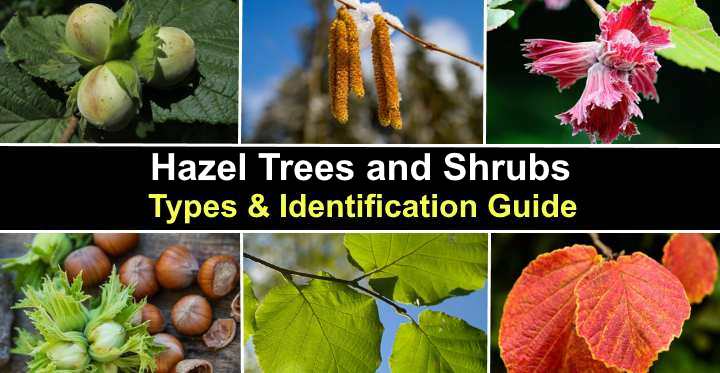
Hazel is a group of large deciduous multi-stemmed shrubs or trees that produce tasty round hazelnuts. Hazel trees and shrubs are identified by their rounded leaves with toothed margins, dangling cylindrical flower clusters, and smooth brown bark. The common hazel (Corylus avellana) is the type of tree producing the most hazelnuts. The American hazelnut (Corylus americana) is a large flowering shrub that also produces edible nuts.
This article is a guide to identifying the most common types of hazels you are likely to encounter in a landscape. Descriptions and pictures of hazel leaves, bark, flowers, and fruit will highlight the features and characteristics of this nut-producing shrub-like tree.
Hazel Facts
Hazel is a flowering shrub or tree in the plant genus Corylus and the birch family Betulaceae. The tree has a clumping habit making it appear as a large shrub with a rounded, umbrella-like canopy. Depending on the hazel species, the shrub-like tree grows between 8 and 20 ft. (2.5 – 6 m) tall.
There are around 18 species of hazel trees and shrubs, many of which are native to eastern and central North America. The hardy deciduous tree thrives in USDA zones 4 through 9 and performs best in full sun and moist but well-drained organically rich soil.
Under ideal conditions, hazels have a medium growth rate and grow around 15” (40 cm) per year. It typically takes up to five years for a hazel tree to reach its mature height. A hazel can grow for around 80 years. Usually, hazel trees and shrubs produce nuts after two or three years.
Common hazels such as the European hazel and American hazel are excellent landscaping plants for small to large gardens. The multi-stemmed shrubs are ideal for hedges, screens, and cottage gardens. To grow a hazelnut tree, regular pruning of the suckers lets you develop a single-stem flowering nut tree.
Hazel Leaves
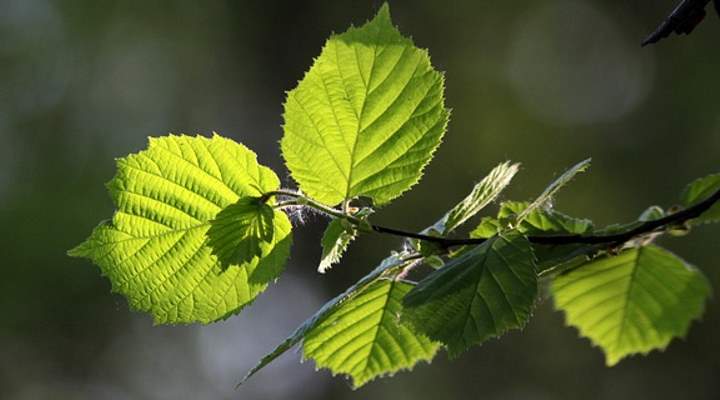
Hazel leaves
Leaves on hazel trees are rounded or heart-shaped with double-toothed margins giving them a jagged look. The simple leaves grow alternately on stems and measure 2.5” to 4.7” (6 – 12 cm) long and wide. Hazel leaves are green from spring through summer before turning golden yellow in the fall.
Hazel Bark
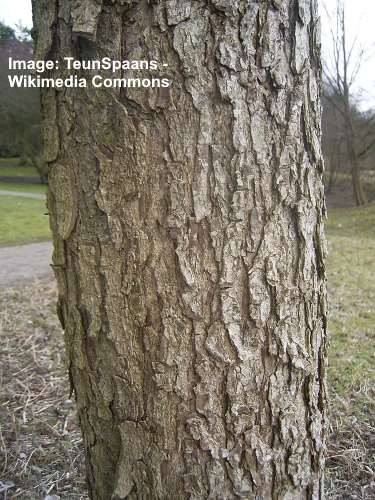
Bark of a mature Turkish hazel (Corylus colurna) tree
The bark on young hazel trees and shrubs is smooth and a light brown or light gray color. An identifying feature of hazel bark is the yellowish-green lenticels or pores visible around the trunk. As the hazel tree matures, the bark develops deep fissures giving it a rough, scaly appearance.
Hazel Flowers (Catkins)
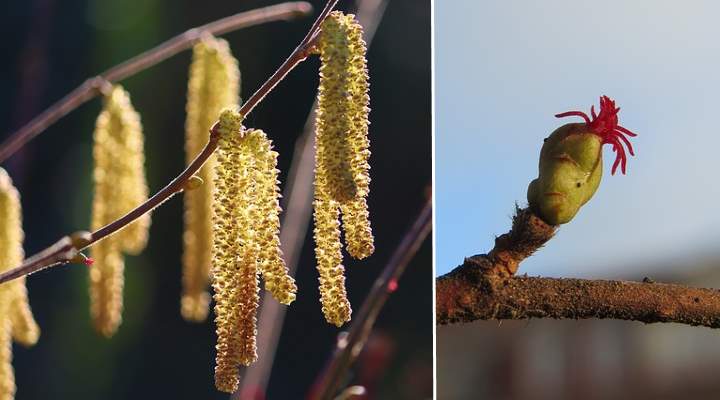
Left picture: male hazel flowers (catkins). Right image: female flowers
Flowers growing on the hazel tree are easily identifiable catkins (cylindrical flower clusters) that bloom in late winter and early spring. The yellow flower clusters with a reddish tinge droop in groups of two or three. Male and female flowers bloom on the same tree, with the small female flowers found on the same twig as the catkins.
Hazel flowers measure between 2” and 4” (5 – 10 cm) long. The masses of pendulous yellowish catkins contrast the light green foliage in bloom.
Hazel Fruit
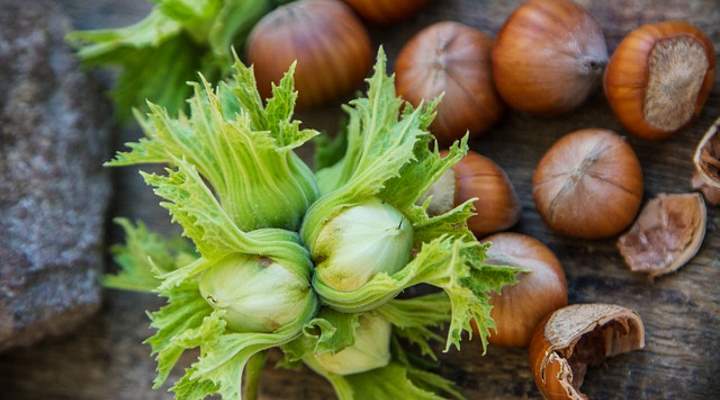
Hazel fruit (hazelnuts): immature and mature fruit
Hazelnuts are the fruit of the hazel tree, and they are small brown oval nuts measuring 0.5” (1.3 cm) in diameter. The hazelnuts emerge green and are enclosed in a cup of leafy bracts. The nuts are a warm brown color with a slightly flattened end when ripe.
Inside the thin, brittle shell is the kernel with a slightly wrinkled lumpy appearance covered in a papery coating. The taste of hazelnuts is described as somewhat sweet with a smoky flavor. Ripe hazelnuts look like small chestnuts.
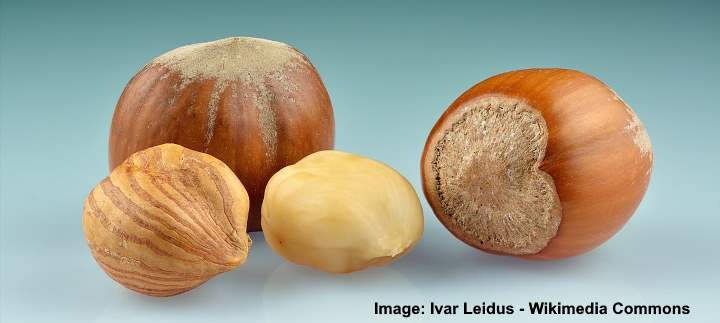
Whole hazelnuts with two kernels (one is peeled)
How to Identify Hazel
Hazel plants are identified by their leaves, bark, flowers, and fruit. Look for a multi-stemmed shrub-like tree with a rounded canopy. The identifying characteristics of hazel include rounded to oval green leaves with double serrated edges. Yellowish catkins appear in late winter, followed by small nuts that ripen from August through October.
Types of Hazel (with Pictures) – Identification Guide
Let’s look in more detail at the most common types of hazel shrubs and trees you can grow in your garden landscape.
American Hazelnut (Corylus americana)
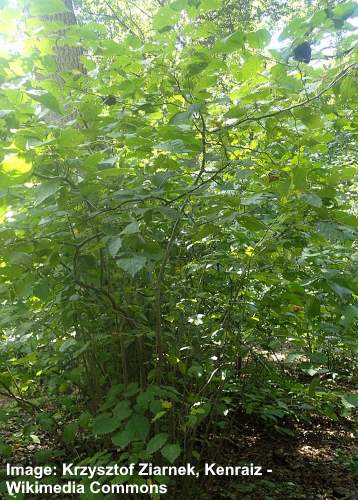
American hazelnut (Corylus americana) shrub
The American hazelnut is a large deciduous shrub with dense foliage, dark green serrated ovate leaves, and showy yellowish flowers that bloom in early spring on bare branches. American hazelnut bushes mostly grow as a clumping plant with outward growing branches forming an attractive rounded crown.
Also called American filbert, the American hazelnut shrub grows 10 to 16 ft. (3 – 5 m) tall and 8 to 13 ft. (2.4 – 4 m) wide. The cold-hardy shrub thrives in USDA zones 4 through 9.
American hazelnut flowers are clusters of red flowers (female) or yellowish-brown flowers (male) growing on the same bush. Showy hazelnut flowers help to brighten up a drab winter landscape when they bloom early in the season. The long cylindrical flowers measure 1.5” to 3.25” (4 – 8 cm) long.
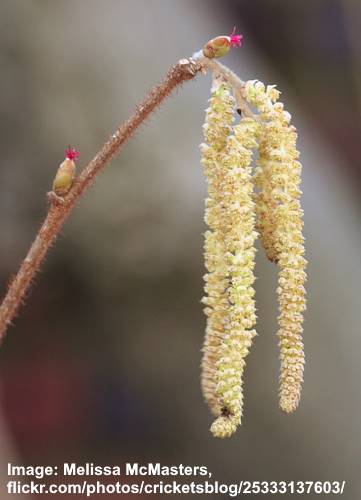
American hazelnut male and female flowers
American hazelnut fruits are edible nuts ready for harvesting from late July until October. The egg-shaped nuts grow in leafy, ragged-looking papery husks. The nuts from American hazelnut shrubs have a similar taste to European hazelnuts.
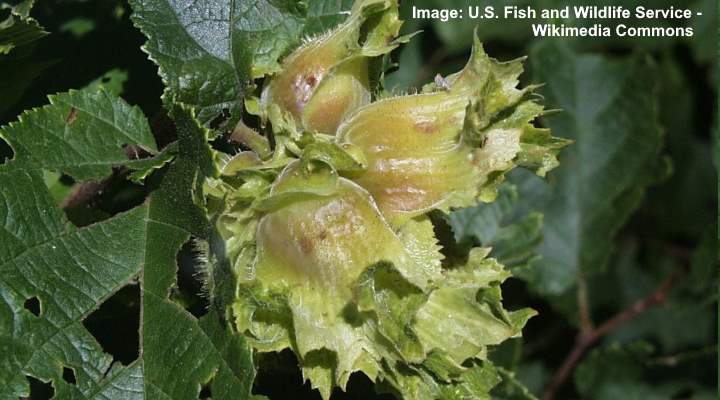
American hazelnut immature fruit
American hazelnut shrub leaves are identifiable dark green leaves with serrated edges and a pointed apex. You will also notice that the leaves have prominent veins. The densely growing foliage is why American hazelnut shrubs are popular for summer hedges. The green leaves turn stunning shades of rose, burgundy, yellow, and orange in the fall.

American hazelnut leaf
To grow American hazelnut in a garden landscape, plant the shrub in full sun to part shade. Typically, the nut-producing shrub performs best in well-drained soil kept moist. Although the shrub prefers loamy soil, it will grow in clay soil. The American hazelnut shrub also grows in the shade but will produce fewer nuts per season.
Hazel Identification: American hazelnut has identifiable dark green leaves with doubly serrate margins. The leaves measure 3” to 6” (7.5 – 15 cm) long. In late winter, you can spot a hazelnut shrub by its yellowish dangling flowers. In the landscape, American hazelnut is a rounded, multi-stemmed shrub.
Common Hazel (Corylus avellana)
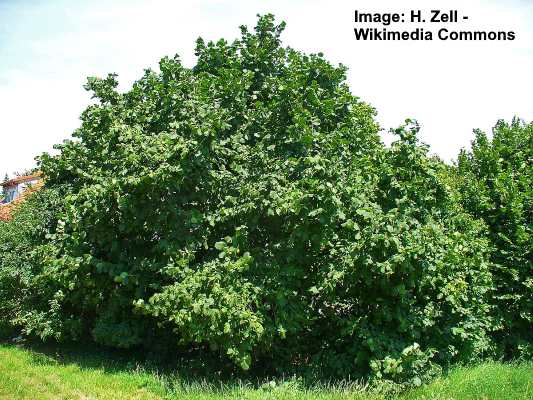
Common hazel (Corylus avellana) shrub
The common hazel is also called the European hazel, and it’s a tall suckering shrub with a spreading, umbrella-like canopy. Common hazel is identified by its showy yellowish flowers, rounded serrated leaves, and edible brown nuts that grow in greenish papery parcels. European hazel shrubs grow 12 to 20 ft. (3.6 – 6 m) tall and up to 15 ft. (4.5 m) wide.
Also called European filbert, the common hazelnut shrub thrives in full sun to partial shade and prefers growing in moist, well-drained soil. The multi-stemmed flowering shrub grows best in USDA zones 4 through 8.
You can plant the hazel shrub in shrub borders, grow as a screen or hedge, or prune suckers to produce a specimen nut tree.
Common hazel flowers are long pendant clusters of pale-yellow catkins that appear in late winter. The dangling flowers measure 2” to 4.7” (5 – 12 cm) long and bloom in groups of two or three. The yellow hazel flowers help brighten up a barren winter landscape in preparation for spring.
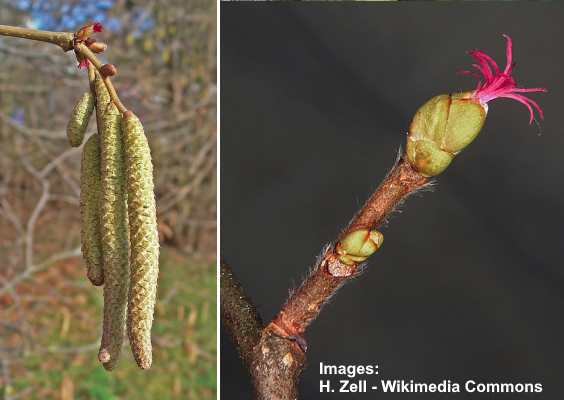
Common hazel male and female flowers
European hazelnuts are plentiful on the upright-growing shrub. Typically, Corylus avellana is grown commercially because of the high-quality brown nuts it produces. The spherical light-brown nuts grow in clusters of one to five and measure 0.8” (2 cm) in diameter.
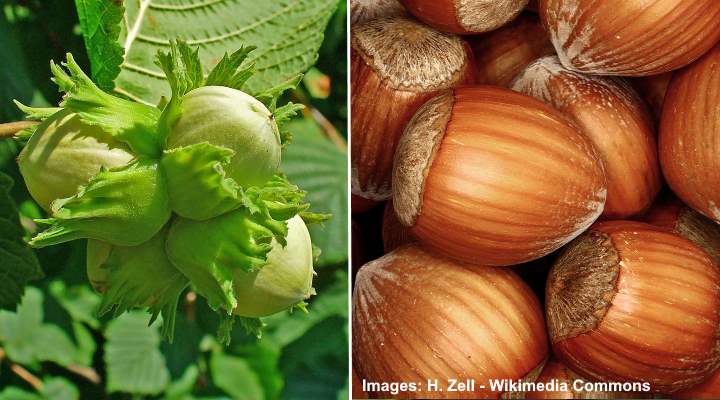
Common hazel immature and mature fruit
Common hazel leaves have a rounded to ovate shape with characteristic double serrated edges. The medium green leaves measure up to 4” (10 cm) long and wide. In the fall, before dropping its leaves, the common hazel shrub’s foliage turns bright yellow.
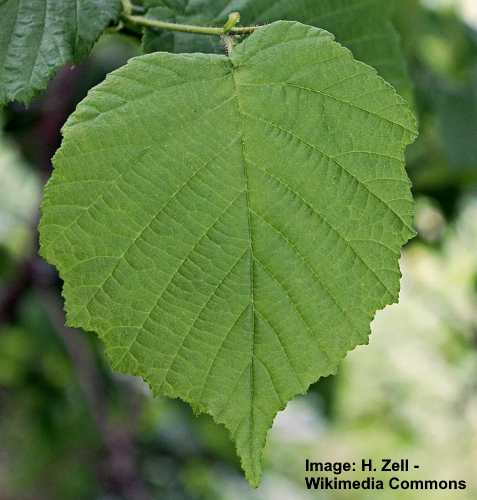
Common hazel leaf
A popular way to grow common hazel shrubs is to coppice the plant. Coppicing a hazelnut shrub requires trimming the plant to encourage more suckers to grow. Coppiced hazel shrubs produce long flexible stems ideal for weaving baskets or fencing.
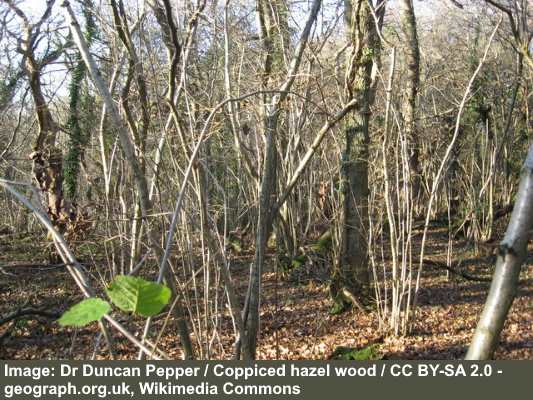
Coppiced hazel wood
Hazel Identification: The common hazel shrub or European hazelnut has characteristic oval leaves with double-toothed margins, long drooping flower clusters, and brown edible nuts.
Beaked Hazel (Corylus cornuta)
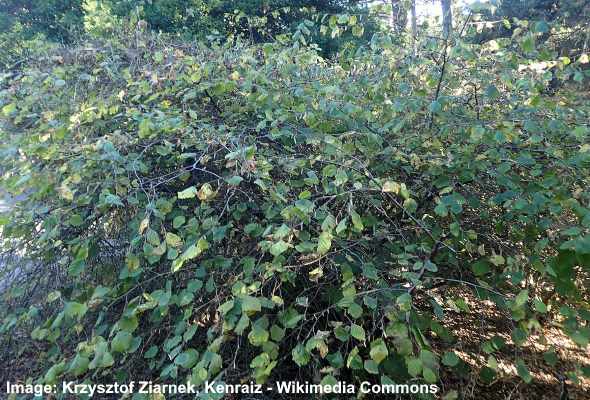
Corylus cornuta subsp. californica (Western beaked hazel / California hazel)
The beaked hazel is a small deciduous shrub with doubly-serrated ovate leaves, drooping finger-like yellowish catkins, and small oval edible nuts. Also called the beaked filbert, the nut-producing shrub grows between 4 and 12 ft. (1.2 – 2.6 m) tall and wide. The hazel shrub is identified in the landscape by its rounded crown and densely-growing thick foliage.
Beaked hazel shrubs produce flowers in the form of cylindrical yellowish clusters that bloom in late winter through spring. The dangling flowers grow at the end of short branches and help add color to a winter garden.
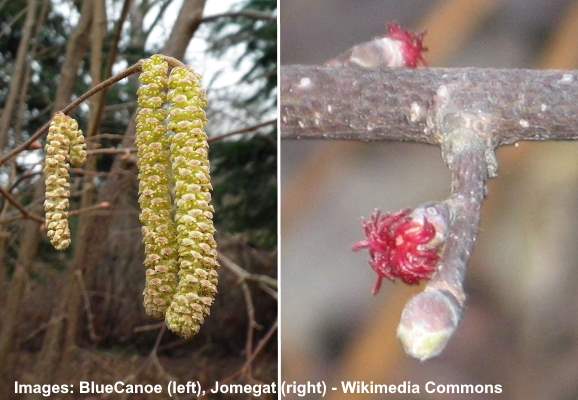
Beaked hazel male and female flowers
An identifying feature of beaked hazel shrubs is their unique fruits. The edible brown nuts are found in hairy green husks formed as a long tubular beak. The delicious, rounded nuts are ready for harvest in late summer and early fall.
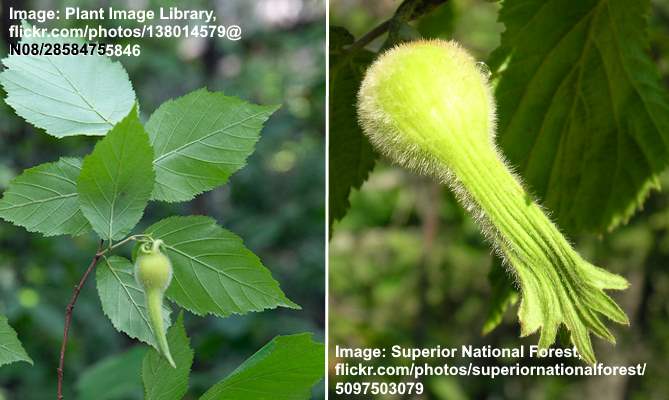
Beaked hazel immature fruit
Another characteristic of beaked hazel plants is their rounded medium green leaves with pointed tips. Like all hazel shrub leaves, they have double-serrated margins. Beaked hazel shrub leaves also have fuzzy undersides due to the soft hairs. In the fall, beaked hazels turn golden yellow.
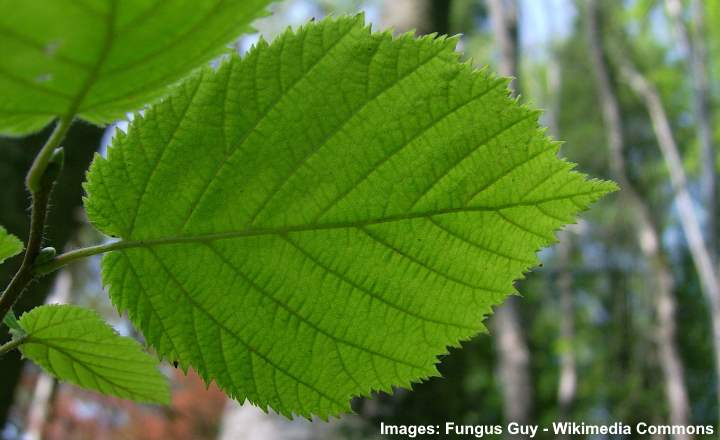
Beaked hazel leaf
Hazel Identification: Beaked hazel shrubs are easy to recognize in the landscape due to the long, extended beak-like reddish or green husks covering the fruit. Beaked hazels have identifiable pointed leaves with serrated margins and yellowish catkins.
Filbert (Corylus maxima)
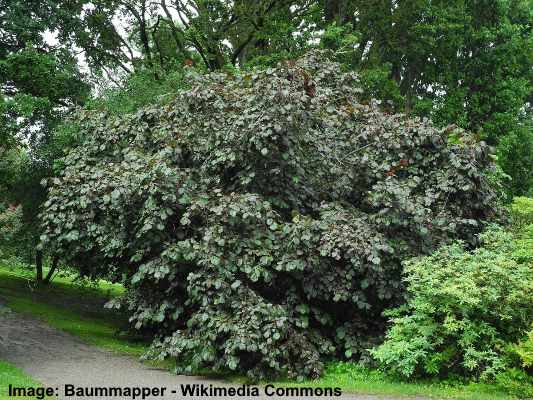
Filbert (Corylus maxima)
Filbert is a large hazel shrub with rounded leaves, pale yellow catkins with a hint of red, and clusters of edible brown nuts. As a large hazel shrub, filbert grows 12 to 15 ft. (3.6 – 4.5 m) tall and has a spreading rounded canopy. Like the beaked hazel, the edible hazelnuts are encased in a husk with an extended beak-like casing.
Unlike other types of hazelnut plants, filbert is a species that more resembles a tree. Although it has suckering growth, the multiple stems tend to grow close together, forming a vase shape with a rounded crown.
Filbert has dark green leaves that are broadly ovate with double-toothed margins. The undersides of leaves have soft hairs, giving the foliage a fuzzy feel. Each leaf measures up to 5” (13 cm) long. The dark green jagged leaves turn an unimpressive yellow color in the fall.
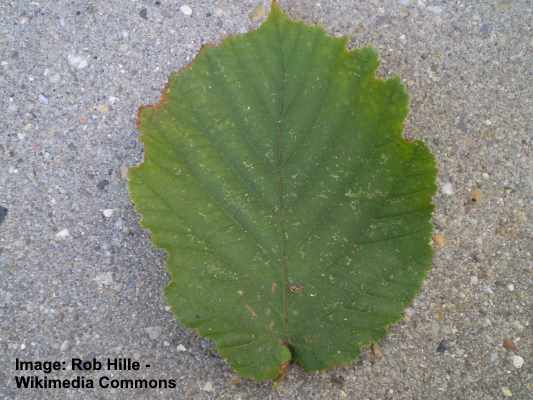
Filbert leaf
Like all types of hazelnut shrubs, filbert catkins bloom in late winter or early spring with clusters of long pendulous flowers. The long finger-like dangling flowers are pinkish-red or dusty pink and measure 2” to 4” (5 – 10 cm) long.
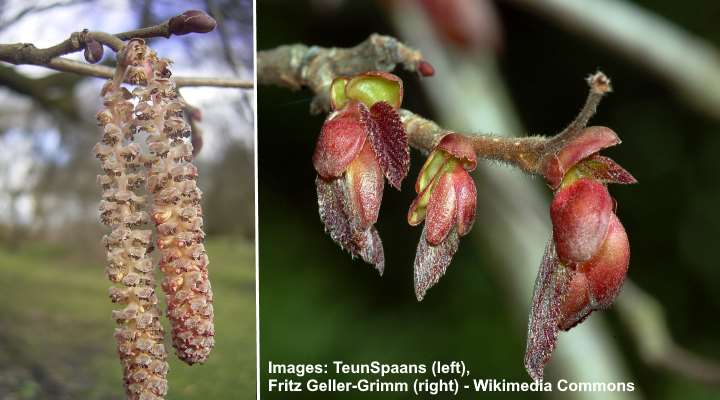
Filbert male and female flowers
After flowering, clusters of nuts appear in green and red husks. The papery husks look like beaked hazel fruits, and the large nut inside measures 0.5” to 1” (1.2 – 2.5 cm) long.
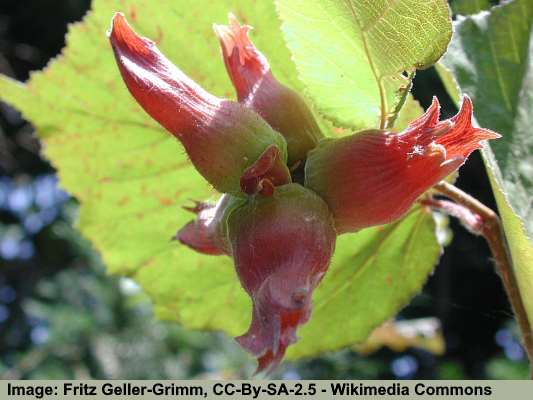
Filbert fruit
The hazel species Corylus maxima is closely related to the common hazelnut and grown for nut production in the United States. The way to tell filbert apart from the European hazelnut is by the tubular husk’s shape.
One of the most spectacular varieties of hazel is the cultivar Corylus maxima ‘Purpurea.’ This attractive hazel plant has dark purple, almost black leaves and is popular for growing as an ornamental landscape shrub in gardens.
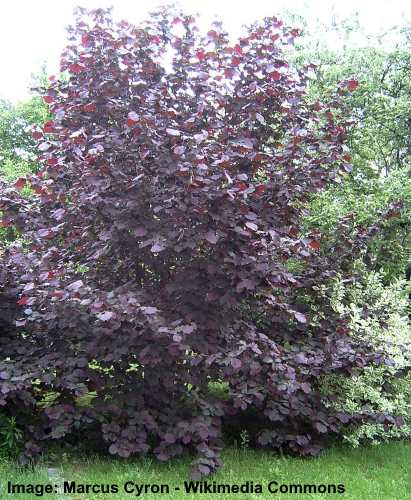
Corylus maxima ‘Purpurea’
Hazel Identification: Filbert hazel shrubs are identified by their rounded light green leaves with doubly-toothed margins, pale reddish-pink drooping flowers, and hazelnuts growing in green and red tubular husks.
Turkish Hazel (Corylus colurna)
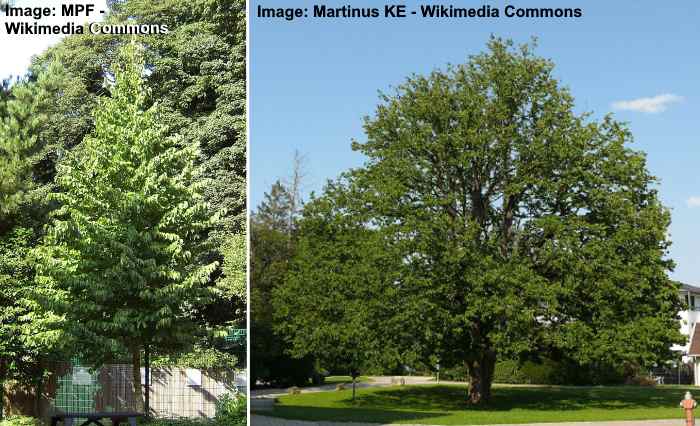
Turkish hazel (Corylus colurna) young and mature tree
Turkish hazel is a deciduous tree with a recognizable pyramidal crown, short central trunk, and broadly ovate glossy green leaves. The spring-blooming tree produces yellow flowers. Bark on the Turkish hazel tree is described as corky bark with a mottled gray texture, peeling to reveal patches of orange.
Turkish hazel trees have characteristic flowers growing in dangling clusters of pale-yellow catkins. The inconspicuous flowers measure 2” to 3” (5 – 7.5 cm) long. Compared to other hazel species, the Turkish hazel blooms later in early spring rather than late winter.
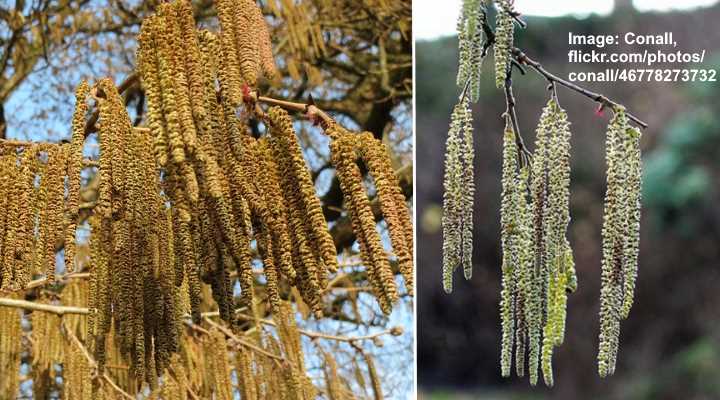
Turkish hazel male flowers (catkins). Right picture: tiny reddish female hazel flower between the male catkins
Turkish hazel leaves are simple leaves with an obovate or ovate shape and toothed margins. The glossy green leaves measure 4” to 8” (10 to 20 cm) long and up to 4” (10 cm) wide. When the leaves change color in the fall, Turkish hazel leaves turn a dull yellow color.
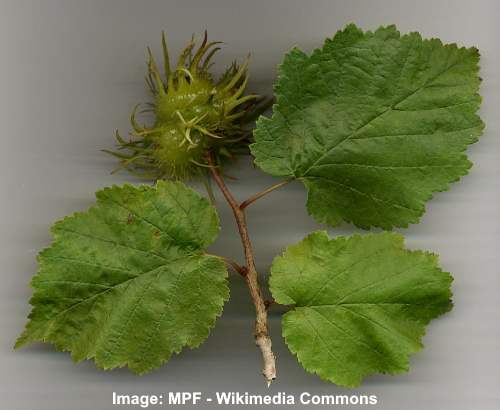
Turkish hazel leaves and immature fruit
Turkish hazels are hardy in USDA zones 4 through 7 and grow throughout the United States, apart from Florida, southern Texas, and California. The hardy tree tolerates cold winters, hot summers, drought, wind, and various soil types.
The fruit of the Turkish hazel tree is about (0.4″ – 0.8″) 1–2 cm and is encased in a spiny or bristly soft husk except for the tip of the nut.
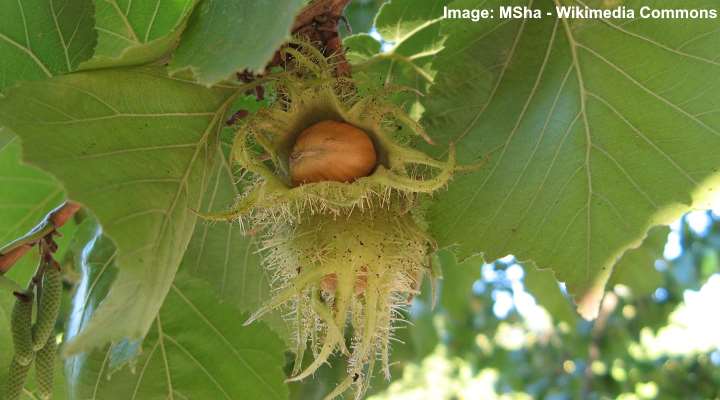
Turkish hazel fruit
Unlike most other types of nut-bearing hazel shrubs, the Turkish hazel is an upright tree with a central leader. Therefore, there are no issues with having to prune suckering stems to create a large shade tree.
The Turkish hazel is a tall, majestic nut tree that grows 40 to 80 ft. (12 to 24 m) tall and has a distinct attractive conical shape.
Hazel Identification: The Turkish hazel tree is identified by its pyramidal crown, yellow catkins growing in small clusters, nuts encased in hairy husks, and large shiny green leaves with serrated margins.
Asian Hazel (Corylus heterophylla)
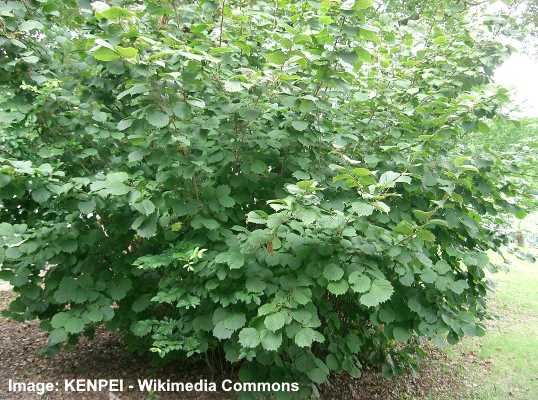
Corylus heterophylla var. thunbergi
The Asian hazel is a deciduous shrub-like tree producing pale yellow catkins, clusters of edible nuts, and round leaves with serrated or lobed edges.
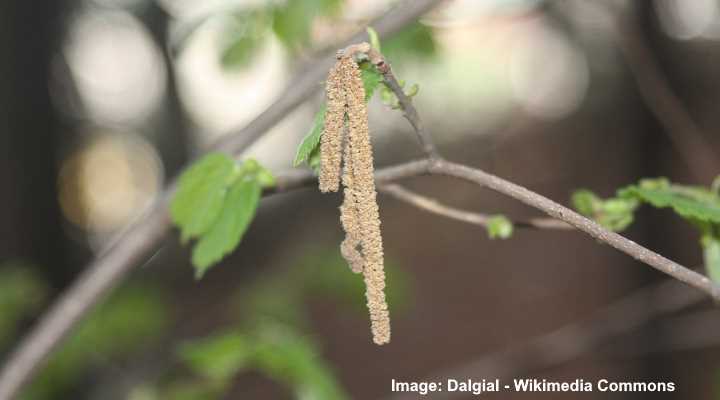
Asian hazel flowers
The Asian hazel grows up to 23 ft. (7 m) tall and has thick stems. In its native Asia, the Corylus heterophylla is also grown commercially for its delicious hazelnuts.
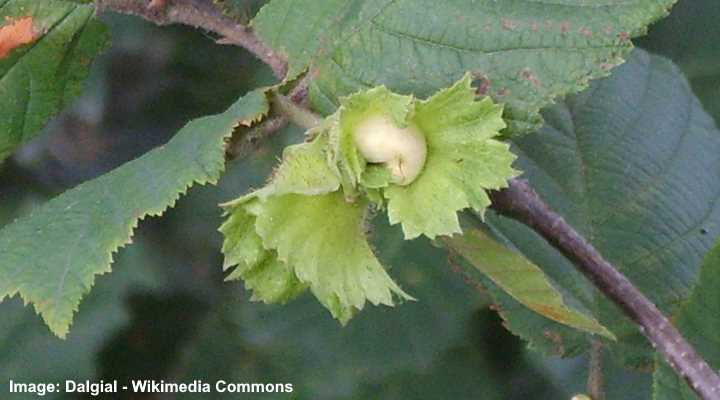
Asian hazel immature fruit
The way to tell the Asian hazel apart from the related common hazel is its serrated rounded leaves with truncated apex at the opposite side of the leaf base, giving it the appearance as if the leaf end is cut.
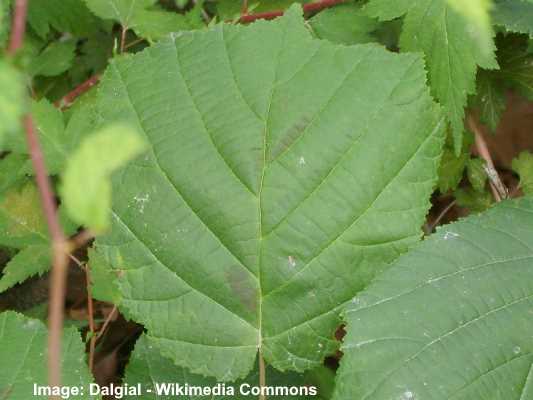
Asian hazel leaf
Yunnan hazel (Corylus yunnanensis)
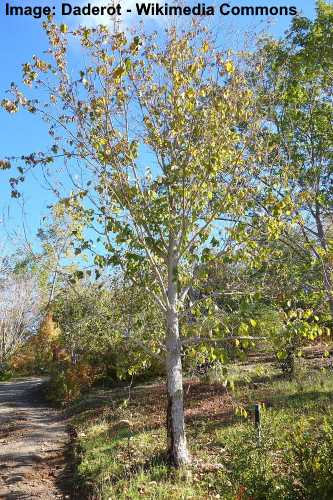
Yunnan hazel (Corylus yunnanensis) tree
The Yunnan hazel is a small nut-producing tree with characteristic ovate leaves with double-serrated edges, small cylindrical clusters of pale-yellowish brown flowers, and round nuts. Yunnan hazels are ornamental trees that grow up to 23 ft. (7 m) tall. This hazel species is recognized by its spreading, upward-growing branches.
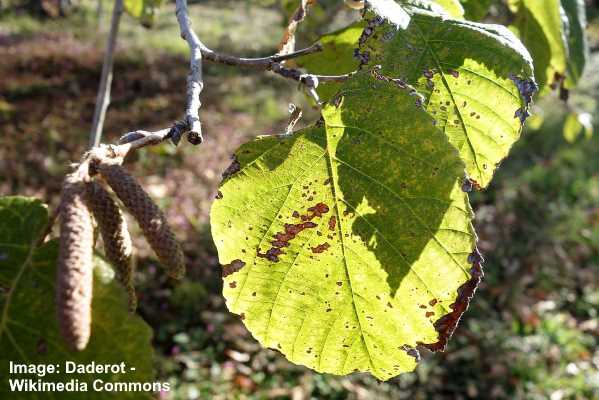
Yunnan hazel leaves and catkins
Related articles:
